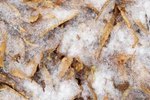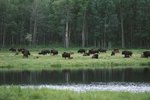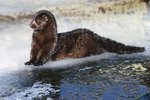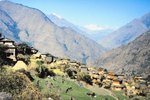
Along the northern coasts of North America, Greenland and Eurasia lies the treeless arctic tundra. During the long winter, it's covered in deep snow, with an average temperature of minus 30 degrees Fahrenheit, and throughout the year there is little rain and winds of 30 to 60 miles an hour. Only low-lying and hardy plants can survive, but the tundra is home to several species of hare, with physiological and behavioral adaptations that enable them to thrive in this harsh environment.
Arctic Hares
Arctic hares (Lepus arcticus) inhabit the bleak mountainous tundra and treeless coasts of northern Greenland, some of the Arctic islands and Canada. Thick fur helps the arctic hares survive the extreme cold, and their coats turn white in winter for camouflage in the snow, molting to a brownish-gray or blue-gray during the summer. With large, padded feet, arctic hares move easily over the snow. To find food, they use their strong claws to dig through the deep snow. Dwarf willow makes up 95 percent of their diet, but they will eat most plant matter and occasionally meat or fish. Arctic hares are sometimes solitary, but for warmth, they will huddle together in shelters dug out of snow.
Alaskan Hares
Alaskan hares (Lepus othus) inhabit northern and western Alaska on upland tundra and rocky slopes. Like arctic hares, they have white winter coats and large hind feet for traveling over the snow, and strong claws for digging. Most hares produce two to four litters a year, but Alaskan hares have just one, giving birth to four to eight young, called leverets. The mothers nurse their leverets for five to nine weeks -- longer than many species of hares -- as this extra nutrition helps their young to grow quickly in the short Alaskan summer. Adults and young Alaskan hares appear oblivious to cold rain and snow, ignoring the elements rather than looking for shelter.
Mountain Hares
Throughout the Palearctic, mountain hares (Lepus timidus) inhabit areas where the forest and tundra meet. These hares molt three times a year, going from brown to white-gray in October to January and then white to brown again by May. The adults shelter in forms -- depressions in the ground or snow -- but their leverets sometimes use burrows. The tundra mountain hares -- some live in forests and the moors of Scotland and Ireland -- eat mainly alpine plants supplemented by lichens, bark and grasses. It's rare to see mountain hares drinking. This suggests they may eat snow.
Snowshoe Hares
Snowshoe hares (Lepus americanus) live mainly in the boreal forests -- coniferous forest connected by fens and bogs at the southern edge of the arctic tundra in Canada and northern United States. They feed at night on all kinds of plants, shrubs and trees as they follow their regular paths. Covered in long thick hair, and looking like a pair of snowshoes, the hares' large hind feet, which are 5 to 7 inches long, allow them to travel on top of the deep snow. Like all hares that live on or near the tundra the snowshoes' brown summer coats turn white in the winter.
References
- Beyond Penguins and Polar Bears: Life in the Tundra
- Animal Diversity Web: Lepus arcticus Arctic Hare
- National Geographic: Arctic Hare Lepus arcticus
- Animal Diversity Web: Lepus othus Alaskan Hare
- Smithsonian National Museum of Natural History: North American Mammals: Lepus othus Alaskan Hare
- Animal Diversity Web: Lepus timidus Mountain Hare
- Animal Diversity Web: Lepus americanus Snowshoe Hare
- National Geographic: Snowshoe Hare Lepus americanus
Photo Credits
-
Jupiterimages/Photos.com/Getty Images




